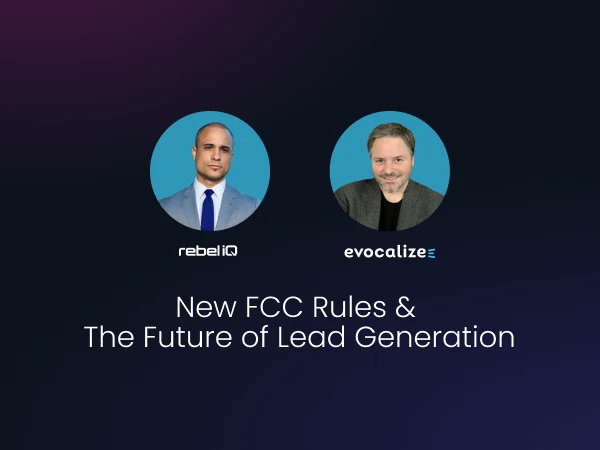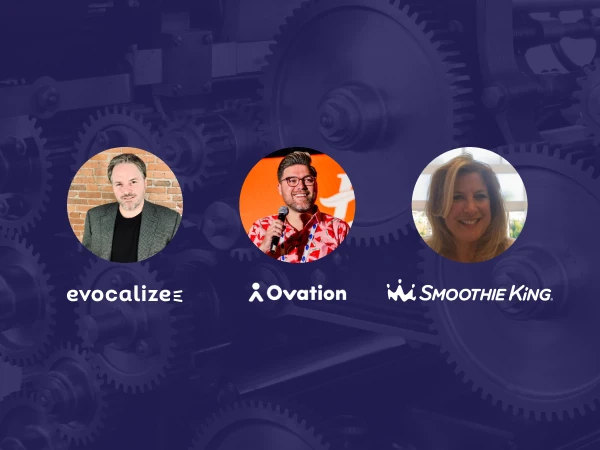How to use data to drive results with local store marketing
In this insightful conversation between marketing experts Matthew Marx and Jeremy Julian on The Restaurant Technology Guys Podcast, they delve into the challenges faced by franchise businesses in today’s rapidly evolving digital landscape. The discussion highlights the importance of data-driven marketing strategies, the role of Customer Data Platforms (CDPs), and the impact of local store marketing on franchise success.
To check out a summary of the podcast episode, view this article on our blog.
Below is a transcript of the conversation:
Transcript
Jeremy Julian:
Welcome back to the Restaurant Technology Guys podcast. We thank you guys out there in the internet universe that tune in and listen to what we got going on. Today, we’re gonna take a pretty cool journey. We’re gonna talk with a guest a little bit about what he’s done in the past and then kind of where it’s tying into restaurants and how they’re doing it.
Matthew, from Evocalize, founder, CEO – you wanna talk a little bit about yourself, a little bit about your history, and then we can talk a little bit about what you guys are trying to do to impact restaurants and, and how we even got connected?
Matthew Marx:
Yeah. Thanks, Jeremy. Super excited to be on and appreciate you having me on to riff about restaurant technology and the things folks are facing today.
I’ve done a number of things in my career. I started out as a software engineer and ended up in strategy consulting in private equity. And then, participated in the IPO of our last marketing software technology back, gosh, almost 10 years ago. And, now we’ve been busy building our company, Evocalize. I’m the founder and CEO of Evocalized for the past eight years.
Fired up to talk about the problems restaurateurs and operators are facing in the space today.
Jeremy Julian:
I love it. And I know, you didn’t start in restaurants. So why don’t you give a little backstory of where you guys came from? And we can talk a little bit about kind the history of where you guys came from and why you thought restaurants was a fantastic vertical that needs a solution, like what you guys have.
Matthew Marx:
We actually didn’t even set out to start in residential real estate. We just started with the problem, right? And the problem we set out to solve.
Like today, if you look at the marketing landscape, local businesses in particular – when they’re talking about generating demand, generating real demand, we’re not talking about social posting or reviews or any of that stuff. All valuable pieces of a marketing puzzle. How do you bring people into the restaurant, into the store?
How do I get people to buy and sell homes that are going on market or on market, right? And so, if you rewind time, a lot of that marketing is done with people hands on keyboard pressing buttons on Facebooks and Googles and TikToks and everywhere else, right? And so, Um, we set out, almost a decade ago after taking our last company public, with the goal of how do we automate that?
So how do we take, the massive amounts of data that are being thrown off from businesses, and locations in particular, like point of sale data and lots of other data, and how do we turn that into marketing that actually, brings results? So we took our first venture capital round out of the largest venture capital fund in the Pacific Northwest at Seattle Madrona Venture Group.
And so we hired a bunch of folks from Amazon and we went to work with one of their portfolio companies at the time, Redfin, and wired in a bunch of data together. We worked with their data scientists and data engineers and basically developed a pretty sophisticated way to take a lot of this moving, changing data in the real estate world.
So think about a home listing. If you’ve surfed on realtor.com or Zillow or Redfin or any of the major real estate portals, you see all the data that these folks have, crime data and school data, listing location, and imagery.
So all that we ingested into our technology every day and started making decisions at a pretty mass scale in order to match homes with buyers and sellers across the industry. And then fast forward to today, where a pretty large percentage of marketing in the residential real estate space flows through our technology in one way or the other.
But this problem is not one that’s unique to real estate, right? It’s the central partner has a bunch of data and they have a bunch of knowledge on how to market. They have sometimes agencies that are creative agencies and agencies that are feeding lots of great, polished creative, but we know local marketing works better, right?
And so how do we set out to basically bridge that gap? How do we equip the franchise location or the local office with the ability to run these really data-driven, complicated demand generation programs to bring real results without having to know how the heck to do it or have all the data to make it happen?
So that’s a little more than I wanted to go, but that’s effectively what we’re doing now. We’re moving and making a big bet in restaurants because we feel like there’s such a big opportunity here to free the franchisee by giving them the power to push a button and have people come in when they’re needed or even automate that thing fully based on their sales data, their inventory data, and all the other cool stuff.
Jeremy Julian:
Well, and I know, Matt, when we talked previously, like the whole idea of local. Longtime listeners know I just bought a home. I just moved to Texas a couple years ago. I was one of those transplants from the west coast, came to Texas.
The local aspect of it – same thing with restaurants. I’m oftentimes not gonna look for a restaurant that’s 40 or 50 or 60 miles away unless I’m looking for a specific destination or I’m looking for some type of cuisine that I can’t find locally.
So I love when you and I talked previously about tying my needs, requirements, where do I like to go, and the data that goes along with that, with something local. Whether it’s, restaurants, churches, convenience stores, drug stores, grocery stores, the more localized you can get, the more you can drive that behavior if you’re where the demand needs to be and wants to be.
Talk to me a little bit about that, because I think it’s an interesting paradigm where restaurants don’t understand how much that data is important to them.
Matthew Marx:
E-commerce kind of leads the way here in terms of sophistication. They’re usually the point of the sphere in terms of like industries using data because it’s so cutthroat, right? And Amazon maybe sets up that landscape for everyone.
But data is everything in terms of having effective, cost-effective digital marketing that reaches the target audience. That’s like a broad statement that I’m sure lots of folks listening will say, “Yeah, whatever, Matt. Everyone knows that”.
But when you compound that with the events and local information going on at the local level, right? I always talk about inventory and sales data because, to me, those two things are fundamental to the local operation.
But we take that with events that are going on around the particular location, right? We have a restaurant partner in the Mid-Atlantic. We’re triggering events, triggering marketing, and specific marketing promotions when the local team wins football games.
We can take advantage of weather data, local event information, sales trends, history, point of sale data, and inventory data. That stuff makes a real difference. We see 30% to 50% increases in performance across our client base.
We have more than a million businesses using our tech now. It’s significant – 30 to 50% increases in performance just by making your messaging, creative, and marketing local. Putting the local flare of the restaurant into it matters because we’re still a neighborhood-based society, right?
We resonate with the store down the road, not always just the corporate branding that’s thrown out in generic.
Jeremy Julian:
I’ll ask you to double-click a bit, Matt, on the whole idea. You talk about e-commerce leading the charge, and restaurants are often laggards in this regard. The show was born out of the aim to raise awareness about companies like yours because many restaurant people I talk to dismiss it as not real.
Because I talked to people in restaurants and they’re like, “Nah, that’s not for real”. And then, and then I’m like, “No, no, no. I have people that are doing this kind of stuff all the time.” But e-commerce has been leading the charge because they oftentimes know who the customer was.
When I was searching for homes on Zillow, (I bought my home two years ago this week at the time of this recording) and I’m still getting advertised for homes from Zillow. That are in the neighborhoods that I was looking in when I bought, “This house became available on the market.” So they knew who I was, they know what my price point was, they knew what I was looking for.
I gave them much of that data to allow them the opportunity to do that. Restaurants struggle there. They don’t have the opportunity often to do that. I understand why e-commerce is there and why they’ve gotten there, and I think for our audience, help educate them on how brands like yourself and others are capturing that data because so much of it’s becoming more readily available as tech is starting to converge where I actually know who Jeremy is and that he’s in this demographic with this amount of kids and eats pizza every Friday night, and I need to move him from this pizza place to that pizza place.
Oftentimes our restaurateurs go, “You’re full of crap. They don’t really have that data to be able to talk to these people.” I’m gonna let you riff on that for just a few minutes because I think it’s informative for people to understand how much is out there and how much the data can actually move the needle.
Matthew Marx:
The platforms themselves have an astounding amount of data. Sometimes so much that the gov governmental entities get nervous about ’em, right? And people get anxious about it. They know a tremendous amount about folks.
In marketing, in two halves, we split the universe of audience known customers and unknown customers. And so when you go to Zillow, you’re kind of existing in the middle ground, but we treat you as a known customer because you’re poking around Zillow and you’re searching for homes.
And we start to pick up. We start to pick up signals about what you’re interested in, where, what bed/bath you’re interested in – and that’s called remarketing. Those are remarketing signals where we’re picking up and learning about you based on your activities on the first-party website, the website that you’re on in that moment.
So, that’s one group of data. The other group of data is unknown customers, your CRM database, your loyalty database. The folks who have expressly said, “Hey, I’m a fan of your location. I’m a fan of your business. I’m signing up expressly to give you my information.”
And so those people are known customers by identity. We know people here just because we know their attributes and what they’re looking for. We know people here because they’re in a database. Those two are known customers. We can market to them. We want them to come back in. We want them to be influencers.
Those are both pretty easy, right? We set up automated programs and we can trigger promotions to them. The more important part to me about those groups of people is that can use those people to build models of ideal customers that are dynamic, and we then go and try and find those users.
Based on everything that Google and Meta and TikTok and all the other platforms know about you, right? So we can go find people based on lookalike modeling from your existing customers and your best customers and new customers, and then we can work on incrementality. So how in your restaurant location do we run programs and promotions to only the incremental new customer you want to bring in for the first time?
We’re paying for you through a promotion if we offer a promotion, right? So we don’t necessarily want to give that to our existing customers. Maybe you want to do incremental customers. So we bring them in and then those two become kinda a yin-and-yang of digital marketing: the known customer-sets and the unknown customer-sets (or prospects that we’re trying to pull in).
And again, both of the platforms know who’s in your family. They know what you’ve searched for recently. They know where you’re traveling to. Last time I checked, had thousands of attributes in them, and they’re incredibly predictive.
So even if you aren’t, and this is what prompts people to sometimes say, “Hey, I know one of these platforms is listening to my phone” and actually they’re not. In order to get certified as partners, we actually had to sign an affidavit with some of them saying we’re not doing that, so they’re not. But, they’re so predictive it feels like they are.
Jeremy Julian:
Oftentimes we give it to them. This came up this morning and I’ll say it for the benefit of our audience. We’re considering taking on another line of business. Somebody sent me a YouTube video about that line of business and it was an internal education video.
Not publicly listed on YouTube, and I sent it to our leadership team and said, watch this for 45 minutes and see if this is something that we want to do. Like this partner, we’re not gonna compete with them. They’re in a different state. And within two days, people had in their Instagram feed and in their Facebook feed stuff that was related to that because we’ve given them that data.
It’s not that they’re listening, they’re watching the web activity. I tell people a funny story and you’ll probably chuckle about this because you live in this world. I went away with my kid to a college visit. He forgets to turn in a homework assignment, recognizing he forgot, but he didn’t bring his laptop, he only had his phone.
So he says, “Dad, can I jump on your laptop real quick? I’m gonna go on Google, go submit my paper to my teacher”. And he had logged out of my profile and then logged into his. Then I got my laptop back and I’m like, what did you do to my laptop? What happened?
Everything is different because my Chrome windows weren’t anywhere close to what I wanted. We don’t like it when they don’t give it to us. When I accidentally log into my wife’s Amazon and I get a bunch of her crap. Like, it bugs me even though we’re on the same account. I don’t want all of this stuff. I don’t need dresses on it. I need the stuff that’s relevant to me. And at the same time, people say “The government’s always spying on us and looking at these things”. This, at the end of the day, you’re signaling to them that you’re gonna be doing this. And so how do brands take advantage of that to help drive incremention or discovery of brands.
My family loves Indian food. We moved to Texas, not the same kind of Indian food as we have in California, trying to find a good Indian restaurant. If the Indian restaurants are out there and they know that I’m looking for Indian food, why not figure out how to get to me?
So, I guess talk to me a little bit about how brands are using that data in an ethical way to drive discovery and to drive behavior from guests and potential guests that they didn’t have before.
Matthew Marx:
Just like I mentioned, businesses throw off data, and those are the signals we pick up and use through technology for automatic marketing.
But, people throw off data too, right? You’re throwing off signals all day long, every day, right? And the people around you are throwing off signals and so those things are being picked up. By all of the channels. And frankly, that can be scary and there are privacy controls you can go in and adjust a bunch of those things in the platforms. They’ve been mandated, so they’re there, they’re a little hidden, so you have to dig for them a little bit.
But from a personal perspective, I don’t personally mind it a whole lot. As long as I have the control, I have goods and services that discover me that I want, right?.
I’m an avid backpacker. I love backpacking and going through like 50, 100-mile backpacking trips through the PCT and other areas. I spend way too much money on cottage gear and backpacks and trying to find ultralight equipment.
Jeremy Julian:
Ultralight tents. I get it. We’ll have to riff after the show and I can talk to you about my John Muir Trail about seven years ago. But we can talk about that later.
Matthew Marx:
I haven’t done JMT yet, but I’d love to talk about it. I love it when new gear finds me and so when my interests are known and there are things that I can control, if I don’t wanna be known for this, I can turn it off.
For a business that’s super valuable, right? Because we want to be places where folks have high intent. Meaning I wanna go to dinner right now or next week. Or to your point, like, I’m hungry for any Indian food. What can I find around me?
So that’s Google Maps, Google Search, some of this specific restaurant spots like Uber Eats and others. We want to be there. That’s an important place to be. But how do you place the intent? How do you create the intent? Well, it’s through this serendipity that I talk about where you’re using the right data, instructing the platforms to match it against the people that are likely to want to come in the next day or week or month. And to pull them in when they otherwise wouldn’t have come. And so it’s kind of like Inception. I think about the movie Inception, like we’re planting the seed that sparks the desire to come into the restaurant.
And by the way, it takes multiple touches. In multiple channels. There’s a bunch of research in the e-commerce space that it takes 15 to 18 touches across platforms for a given customer in order to get them to buy a product. You have to be locally omnipresent.
It doesn’t have to cost a ton of money if you’re doing it the right way. It can be really efficient cost-wise but, it can really drive your business.
Jeremy Julian:
There’s a whole bunch of thoughts I have on it. The first thing is you were in the real estate space.
Real estate is a once every seven to 10-year activity. Restaurants are not, they’re weekly, they’re daily. For a lot of people, they’re multiple times a day. I guess how has the paradigm have to shift for you, your team, going from real estate where I might be buying a new home every seven years to buying pizza from this brand or that brand Tuesday?
Talk to me a little bit about how you guys normalize that and even the different frame of mind, because it sounds to me it seems they’re different. There are different ways to skin the same onion.
Matthew Marx:
I think that cost per purchase is pretty different, right? The economics of the consumer are different. When you’re making $20 versus you’re making $200,000 right? Or $20,000. The economics are different, but at a unit level, really the marketing is very much the same.
The real estate companies are all trying to transition and transitioning into a lifecycle marketing mode. And that may be why you continue to get marketing from Zillow after you had sold. There’s some delay in the home industry, like there was actually a transaction and that there’s some footing of that that has to take place.
But frankly, a lot of the brokerages and agents out there are starting to lifecycle market because they don’t want one-and-done. They want to maintain. The best teams and real estate agents in real estate maintain a relationship with customers and they’re digitally present.
Jeremy Julian:
The first three homes that I bought, I bought from the same person in California.
Matthew Marx:
You’re super rare, right? Because the stats say it’s a 90/10 rule. Where 90% of the folks do not buy more than once from the same realtor agent.
Jeremy Julian:
Interesting. I bought from a different agent here in Texas because they weren’t licensed. I tried to get my loan from the same person. But they weren’t licensed in Texas. The person that was servicing my home loan in Southern California, fortunately, gave me somebody that was good here, and they got a service. But that’s ironic. I wouldn’t have considered that because of my own personal experience.
Matthew Marx:
That’s loyalty, right? And so that’s what we strive for across industries, right? It crosses industries, right? Whether we have lots of mortgage partners and insurance partners and real estate firms and some restaurants, as we’re spinning up in the restaurant industry, loyalty is the same across these industries.
In some cases like real estate, it’s more difficult because you have to create a reason to interact. Probably everyone on this call has gotten local market statistics emails, right? For your local home or your home values.
Jeremy Julian:
For the door hangers, you know, all these homes sold in these neighborhoods. That’s super local, you know?
Matthew Marx:
Totally. I mean, that’s the example or the parallel to your local restaurant, your location sending out marketing on an every week basis. Always having something running and then always having the promotion, the digital promotion and pulling people in.
That’s the equivalent because the cycles are much shorter in restaurants. But, the concept is the same, right? We want to maintain a connection with the customer so they don’t go to the next competitive restaurant around the corner. They think of me first.
My kids think of the Subway when they drive down the street every time because Subway’s in front of them with local marketing in TikTok, right?
My daughter has ordered from our partner, Smoothie King out of TikTok online ordering. So the TikTok came, the TikTok from the local Smoothie King restaurant came to her and she was 15 at the time and clicked the button and they delivered the smoothies to the house.
The whole world is changing around this, and we have to be digitally present at our local level so that folks are always thinking about us all the time. I love that it’s more important in restaurants, even with the shorter cycle times than it is in real estate.
Jeremy Julian:
The amount of competition that’s there is greater than it ever has been. And unfortunately, and one of the things I often say on this is if you’re not doing it, I promise you your competitor is figuring out a way to do it. And so, before we talk a little bit about the franchise model, cause I love that you guys are getting down to not just, oh, I’m selling Smoothie King and their 2000 stores or 800 stores, whatever the number is, you’re going to the local guy and helping with that.
Talk to me a little bit about attribution and even this whole idea, like the big buzzword in restaurants right now is CDP and there’s a lot of misnomer about CDP and you being from the e-commerce world and even you probably chuckle because you’re like, “yeah, that we’ve been doing this forever on that side”, but restaurants are finally getting around to it.
Historically restaurant’s marketing was, “I’m gonna place an ad, I’m gonna hope somebody comes in. And I’m only gonna look at it and say, did traffic go up or traffic go down? Did sales go up? Or sales go down? I would do these LTOs two or three times a year and hope that I got the McRib sold enough to make up for the campaigns that I did”, and they didn’t really have any idea.
So talk to me a little bit about your vision on CDP for restaurants. Because again, tying e-commerce to brick-and-mortar sales is getting easier and easier, but it’s not there completely.
Matthew Marx:
By the way, to kind of riff on the way things have been in restaurants. Like we’re targeting DMA level, like broad messaging and like your brand mark is in front of, and meanwhile, me as a franchisee, I’m paying market development funds. Like I’m funding that. And I’m saying like, what did it do for me? What is that? What is that actually doing?
Jeremy Julian:
They marketed a smart strawberry smoothie to me, and I’m allergic to strawberries, and I’ve never ordered a strawberry smoothie ever. But that’s the new thing that corporate came up with. Sorry, I don’t mean to cut you off, but I hate it.
Matthew Marx:
Yeah, no, I’m totally with you. And then like, That’s what we can get away. I’ll talk, talk about CDPs in a minute. Cause they’re really important. But that’s what we’re trying to get away from, right? Which is: give the local franchisee, it’s their livelihood, who depends on the business to come in every day to the store. They’re paying for staff, they’re paying for ingredients, they have spoilage concerns, right?
When we have excess kale, we need to liquidate. We need to run kale smoothie promotions and get people to come in the store and walk out with a kale smoothie. Otherwise, that kale’s gonna spoil. That’s a real-world concern at the franchise level. And no amount of DMA-level marketing and brand marketing through my market development funds are gonna do anything for that.
Jeremy Julian:
I love it because I think it’s something that people look to every day. Back in the old days before there was chains, the fish special got written on the chalkboard at the front of the dine-in restaurant because you knew that you had to kill all the salmon off, or it was gonna go bad in the next two days.
And so you’re doing that, but broadcasting it to an audience of 10,000 people to hope to get a hundred people to come in and order the kale to get rid of the kale for that period or whatever, whatever the timeframe is.
Matthew Marx:
Yeah, totally. I mean, again, that’s what franchisees have told us they want, right? Stop spending my money. There’s some amount of brand national marketing that works as a part of a full-funnel strategy, but like, give me the visibility to know where my dollars are working and where they’re not and what to do with them.
And make it easy. So I don’t spend much time trying to figure out how to become a marketing expert. Like that’s what the franchisees tell us, and that’s what we’re hearing. Same thing we heard in the other industries.
So CDPs. CDPs have been a pretty big thing for the last five, six years. As you mentioned in e-comm and in – we’ve worked in the airlines and travel industry some and so they’ve been pretty widely deployed there. Venture capitalists has an investment and some CDP technology and so we’re pretty close to it all. We also integrate pretty tightly in a lot of industries with CDPs.
If you think about like, again, we’re the activation of your data. CDPs are the collection of your data. So CDPs are “how do I take this data that’s kind of hard to work with before and siloed in different systems and how do I pull it together in one place so it’s actionable?” CDPs are merged in e-comm and travel and some other industries for the first use case is email marketing, right? So it’s like, “Okay, great. Now I pull all my customers together and I can segregate them into different slices, and now I can email them in different ways. Great.” Like email has a definite place in the puzzle. But so does reaching people in platforms where they’re spending the most of their time.
Because if you’re trying to reach a demographic that’s younger than 30, they’re not spending a whole lot of time in their email every day.
Jeremy Julian:
Oh, believe me. I’ve got teenage kids, as do you. I’m like, “Have you seen the last four emails I’ve sent you?” And they look at me and go, “Dad, just send me a text or send me a Snapchat.”
I’m like, I wanna punch you in your head, kid. So, sorry, I didn’t mean to but, we know it and unfortunately, brands are not thinking about that because they’re run by people that are our age and older.
Matthew Marx:
I have the gray hair, so I’m a part of the club.
I’m trying not to be a part of the problem. So email has its place, but CDPs are bigger than that. It’s a clearing ground. It’s a nice starting point for, like, I think about it like – this is a super non-environmentally friendly example – but I think about it like they’re the oil.
And so you’re like refining the oil and getting it set up and in tanks. And it’s like, “Okay, but that doesn’t make me any money yet.” So it’s good. It’s a necessary but not sufficient part of my marketing strategy. Then it’s “Okay, what do I do with it?” Email is one activation. We take instruction, we take part of our data streams.
Part of our data streams are from point of sales. Part of our data streams are from loyalty. Part of our data streams are from inventory systems. Part of our data streams can be from CDPs to go and find new people that actually make you money at the end of the day but CDPs are definitely foundational to your core infrastructure.
There are three or four of them the technology bits that you have to kinda have, and you wanna choose the right partners that have an open ecosystem where they have APIs and they have ways to integrate. So it’s easy. They’re either pre-integrated or they have ways to integrate your data to them and get your data out.
Jeremy Julian:
So that you can have a campaign that goes out and drives the kale smoothie to drive that behavior. That’s right. Love it. I’m gonna ask you to riff a little bit. I’m gonna ask you to boast a little bit about what you guys are doing because I think the whole local concept and giving the tools to the franchisee to both build campaigns that are automated because I think there’s some that you guys do that makes their life easier.
Because if it’s really a tool and I’ve heard this too many times, that they have to go into the office or they have to go create this whole thing and they go get the LTO from corporate and they put it into this tool and it just doesn’t end up happening. And then they’re pissed because it didn’t work. Or they’re spending all of this money on their market MDF funds and their market marketing development funds, and 2% of their sales is going off the corporate. They don’t know where it’s going.
Talk to me a little bit about how you’re making restaurantors lives easier to drive the traffic that they want and need in order to continue to thrive and continue to grow and continue to support their family and such.
Matthew Marx:
I love the way you ended that with “support their family”, and like that’s really what it is at the local level.
That’s why I get back to the, where I got all fired up earlier on transparency and like, where are the dollars going? Because I actually think it’s a pretty big franchise development opportunity for franchisors to be able to give visibility and coordinate marketing with their franchisees.
It’s transparent, so you can see where the dollars are going, can see how they’re working, can see how you compare to the next location up the road in Plano. Or down here in Austin from where you are. And so, so I think like to me, the opportunity is not just for the franchisee, it’s also for the franchisor or the corporate group.
To have a differentiator that like, “Hey, I’m gonna treat my franchisee as a partner in this thing, and I’m not gonna black box their marketing dollars. I’m gonna work with them together and be super transparent with them.” So to get to your point about the personal nature of this and its impact on the franchisee, to me, franchisees, they want control, but they don’t wanna spend hours and hours a week.
They can’t, they don’t have the time. And they don’t wanna become marketing PhD experts. They don’t wanna even understand what the hell a CDP is like at a franchise level. My store location, I’m so busy. Like staffing up and recruiting and trying to get my restaurant in order –
Jeremy Julian:
And writing schedules, ordering product. Producing food. All of it. Yeah. Dealing with the landlord and the leak in the roof, all of it.
Matthew Marx:
Totally. The key is to any product, not just to ours, is how do you make things either fully automated, 100% or so easy that you can push a button and then just look at it, look at a report, glance at a dashboard once in a while and say like, okay, what’s it doing for me?
Or just watch the turmoil coming in and, “What’s happening in the front of the restaurant.” To me, that’s kind of the principle we’ve been told very distinctly from franchisees and frankly practitioners at the local level across industries: “We want easy and we want effective programs that are transparent.”
That’s what we want. And so you can’t, as a franchisee really do that on your own. There are few options that franchisees have when they’re looking at these problems on their own. So, one, this is all a little bit of a quick shameless plug and then I’ll get back to like problem solving…
Jeremy Julian:
But honestly, at the end of the day, there’s people that do what you guys do, but I think you guys have some stuff that’s pretty unique that truly takes some of the friction out of what people are doing. Part of why I was excited to talk with you guys is you guys have created some level of automation.
There’s tools that do what you guys do, but it requires you to build campaigns and do a whole bunch of work and upload a bunch of photos and all of that. You guys have taken some of that friction out and I want you to plug what you guys are doing. Cause I think it’s really worthwhile for people to understand what’s possible today.
Matthew Marx:
Well, we founded the business because the local business, again, I talked about the founding story a little bit, but the local business operator, they do one of three things today. They do nothing digitally. Or they’re doing simplistic things that really they’re just checking the box, like organic social posting.
Again, it’s fine to do, but you don’t really count on it to drive a bunch of business. At the end of the day, you’re not using it as an economic engine. You’re using it as kind of being active in the space. Increasingly fewer people – that’s a misnomer – but, fewer and fewer people are seeing those posts because the platforms are trying to make money so they don’t let organic propagation just show that.
The last thing I saw from businesses was 1% of people that even follow your page, let alone other people, see those organic posts. That’s the second thing they do.
Or the third, they hire an expensive kind of local agency, digital agency that’s trying to figure out what to do for them.
Those are three of the main options that folks go through. Those local agencies don’t really have access to data because like they’re doing pretty pictures and they’re trying to figure out like using channel audiences and things like that.
But what we’re trying to do is a little different. Which is we’ve spent more than $30B building this automation ecosystem and infrastructure that wires directly into the most performant digital marketing channels. So there’s not a human in the middle, right? The franchisee can press a button.
We, we have safeguards around it. Data is all wired in already. And a program can launch because some of these programs are time-sensitive. You can’t wait for it to submit to some human desk in the Philippines, which is what most folks do in the space. And then wait for someone to type it into Facebook.
Business moves faster than that. Especially if you have to update pricing. You have to operate imagery. Your customer’s changing, your inventory’s changing, like that has to be automated. So that’s one. Two, you don’t want to figure out how to go from one channel to the next.
You need to be in all channels, is the answer. And that’s not easy to hear if you’re trying to do things manually. How long does it take me to go in Facebook and run marketing and then go in Google Search and then Google Discovery Ads and Google Display, and then let me go over to TikTok and create a TikTok video and create an Instagram Reel?
And then maybe I’m running something on Uber Eats, or Amazon, right? It’s just too much. So what we do is the franchisor sets up ready-made programs that can be fully automated or there can be some press-button, make some decisions at the local level, and then the franchisee gets those in a little dashboard and can just make a few simple choices.
We use machine learning. I don’t wanna overuse that because people get “uh, it’s too much.” But, we use machine learning to figure out which channel to go reach people on. So you don’t have to think about that because frankly, the audience is different in LA than it is in Kansas City, than it is in Austin.
The channels you reach the consumer is different based on the type of food you have, the price of the food that you have. And so it’s just really hard to make those decisions at a corporate group, let alone at a local operator. So, we take a do-it-for-you approach and wire all the stuff in for you.
Those are things that a location just can’t do on their own. Like even if you had the 30 or 40 or 50 hours to spend on trying to figure out how to do that every week, it’s not the right use of your time and you don’t really have the data to make it happen.
Jeremy Julian:
Same argument that we have about point of sale. Go make cheeseburgers, we’ll solve your point-of-sale problems. You guys solve the marketing problems and I’m not gonna come in and tell you how to make a cheeseburger. Don’t tell me how to run up a point of sale company, you know?
One thing that I always worry about with demand gen is too much restaurants are finite. Physical spaces, finite. Kitchens are finite. Inventory’s finite. Labor is hard to come by and we run an ad and we drive these kale smoothies and then we don’t want people to produce them.
Now that you’ve got a bad guest experience, and oftentimes on the show we talk a lot about guest experience and delivering good guest experience. Because at the end of the day, good guest experience brings people coming back. And when they come back, they tell their friends and such and such. Talk to me a little bit about that problem, and I guess, have you guys even overcome it?
Have you guys dealt with it? Talk to me a little bit about that. You know, even in third party, Uber Eats and GrubHub and DoorDash and such, they struggle with it from time to time too. Where it’s too much demand and then it’s binary. It’s like we either turn it off or turn it on and it’s not delivering on the guest experience. Have you guys had to overcome this yet?
Matthew Marx:
It’s kind of a lot of what we’re all about, because in order to do that, and I’ve talked a lot about data and you mentioned CDPs, but we think about inventory systems, we think about point of sale data too, right?
So if you don’t have access to point of sale data to orient yourself and historical point of sale data to understand times of day and days of week and trends and throughput, then you can’t automate. You have to have your people or you – at the local franchise level go, “I need some more people or pull back on marketing”.
What we’re trying to do, we give those options to folks. So if they want to press demand, they can click a button, it spawns demand. The franchisor will lay out a series of automations where they’ve already wired in inventory data. They’ve already wired in demand data.
They’ve already wired in for every location. Like what do the sales data look like day of week. The system just automatically adapts to that and looks at when do we need to push demand and when do we not push demand? And then promotions can be triggered based on other things like inventory levels and other things.
That’s what talking about these agencies are fine. I don’t wanna bash – agencies are good for creative development, some of these things, but they don’t have connection to your data. They can’t do what you’re talking about.
You have to be connected to the POS. You have to because otherwise, you don’t know what’s going on. You’re just relying on the operator again, and they don’t have time to do it.
Jeremy Julian:
And even if they do, they don’t quite understand what all of that means.
Oftentimes they’re even, you’re absentee owner, you’re on vacation, you’re at the lake, and now you’re now your manager’s sitting there on their hands not driving the volume that you might need to. Matt, I’m gonna ask you one last piece and then we gotta wrap up cause we’re getting close to time.
What does an engagement look like with your team? What’s a brand that I’m going to call your team. I’m going to start working with your team to figure out what this looks like. What’s the onboarding look like? How long does it take to get this set up? Is it like signing up for a rental car and I’m just going online and putting my name in and put my data in?
I’m sure there’s some level of engagement. Talk to me a little bit about what that might look like for a brand that’s sitting here listening, going, “You know what, I have to have this. Where do I go? Figure out how to get my kale smoothies out the door? Lemme get on the phone with these guys.”
What can they expect when they engage with your team?
Matthew Marx:
First of all, if you have to have it tomorrow, you can email us at [email protected]. Hit us up on LinkedIn, hit me up at [email protected].
Jeremy Julian:
You should send me a check and I’ll make your problem go away.
Matthew Marx:
We love to partner with great brands. Obviously, it’s what we’re here to do. But, in terms of engagements, it can be super turnkey, or it can be super customized. We have a client success team that works with you and an onboarding process and team that will work with you to look at – we do this frankly from the conversations upfront and the sales process, all the way through the process, we look at which of these, we have some best practices. We call them blueprints, but programs, that can be driven by your data. We have some benchmarking data around them, so we’ll come with an opinion.
We’re not saying, “Hey, tell us what to do and we’ll go do it.” We’re coming with an opinion, which I feel very strongly about as a software solution provider. Like come with an opinion. So we come with an opinion, and then you kind of can choose from menu or you can decide, “Hey, I want something different.”
For instance, we have some restaurant partners that – we’ve talked a lot about sales and a lot about demand generation. We have some restaurant partners that said, we want to recruit. We want to recruit through your tool. We want to let the local franchisees have a button that allows them to go and solicit recruiting and staffing needs.
We’ve built blueprints, we’ve built programs that again, are driven by data, and that allow recruiting. We have some kind of things that you can get off-the-shelf best practices. And then we have – one of the strengths of our technology is the ability to very quickly modify things.
Because what we want to do is not have a, “this is not a one size fits all deal.” Your data is different than everyone else’s data. Your brand is different than everyone else’s brand. And so we want to have the system at the end of the day, that your franchisees are using or that you’re using at corporate, to drive local marketing, be unique to your brand.
We’ve designed our whole technology to do that. So, not to forget about this. The implementations are as quick as about a week, week and a half, for pretty turnkey solutions.
Wiring in a bunch of specific data that you have as a restaurant group that isn’t already integrated into our system, that could take as much as four, five, six weeks.
Jeremy Julian:
Depends on how easily accessible it is. And again, more so than anything, people are like, “Well, I heard that guy Matt, and he’s awesome. Now what?” And I’m like, “Okay, get on the phone, talk to them. They’ll start to understand what your needs are.”
And I guess I would encourage you guys all to consider rewinding by about two minutes to listen to Matt talk about even recruiting, because one of the biggest challenges I continue to hear from restaurants is staffing, staffing, staffing. I’ve been at four different restaurants in the last two weeks, four different corporate offices in the last two weeks, and they’re like, “Staffing is our biggest challenge.”
And I’m thinking to myself, “You guys are marketing. I see a bunch of marketing about that, but you’re not marketing your jobs and your availability of those jobs.” It’s the same problem. It’s the same. Getting enough traffic, enough eyeballs to see that that’s available to say, “Yes, I wanna click the link to go connect to it, versus going in and ordering the kale smoothie and having it delivered to your house for your daughter.”
Matthew Marx:
My 16-year-old daughter who I just mentioned is looking for jobs. And so she wants TikTok, like you come to her and TikTok and say, “Hey, you know, she’s like a pretty good student. Like she’d be a good employee for someone.” She doesn’t know where to start. She doesn’t go read a sign on the side of a restaurant.
That’s not where she looks. She’s living in TikTok. So anyway, I couldn’t agree more. That’s actually frontier stuff. We do a lot of that in other industries, but restaurants just getting started on that.
Jeremy Julian:
I heard it at RLC, Restaurant Leadership Conference. Earlier this year, people were talking about it. They were saying, ”Have you turned your marketing engine away from consumers? And straight to who’s staffing.” Because you guys keep talking about this, but you’ve got some pent up talent in your office that has not done a good job of – they’ll talk about building the brand and making it sexy that people wanna apply, but go do your CTA that says “Apply today” to come work here. Go figure out what your demographic is and go after those people.
I know our audience is gonna just love and many of them are gonna eat this stuff up. I would expect that you guys will get some phone calls because there’s some people that are excited to do this.
To our audience guys, we know that you guys have got lots of choices. As I said, if you haven’t already done so, subscribe to the newsletter, subscribe to the YouTube channels, subscribe to the podcast, whatever your consumption method.
Matt, thank you so much for your time. I’m looking forward to connecting in person and to our audience. Make it a great day.
Trusted by 1,500,000+ franchisees and local operators
Empower your franchisees.
Drive real local results.
Not every franchisee on your team is a marketing pro — yet.
Let’s change that. Reach out, and we’ll show you how!




























